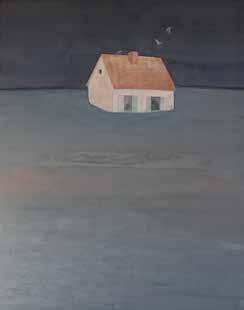
2 minute read
Rae Soon Jung
written by Terry O. Faulkner
You couldn’t blame a viewer for thinking Raesoon Jung’s work is strictly based on houses: shelters traditionally providing stability, comfort, and peace of mind. But upon further investigation of Jung’s work, that stability and comfort becomes distorted, uneasy and foreboding. Unnaturally colored skies of pink and aquamarine predominate many of her pieces. Those lush skies grow darker and the landscape simultaneously becomes more hostile. Water floods the houses and tangible subjects exist within a water, dream-like world.
Advertisement

Silent night
Mixed material on paper, 2019
One work (above) reads “Warum nur ist der Himmel so weit? Ich bin ganz still allein” meaning, “Why is the sky so far away, I am completely alone” admitting to her solitude as a stranger in a strange land. Jung is a stranger as a Korean in Berlin having moved there from Daegu in 2013. Perhaps her art expresses her loneliness in a place where it's hard to meet other people. Her houses reflect a tight, claustrophobic space forcing the viewer to feel trapped. Conversely, the ever-changing environment outside discourages those inside not to venture out.

An unfinished world
Pigment on canvas, 2017
A common theme among expatriates is the isolation from being away so far away from home and friends who understand. On living alone in a foreign land, “Silent Night Part 2” (below) portrays a drab single house with windblown trees and German writing underneath “Freund ist der Fremde nur in der Fremde” roughly translating to “Friend is the stranger from foreign lands.” The trees are the only other objects in the painting. Do the trees provide companionship from the harsh emptiness of the Berlin environs?

Silent night part 2
Mixed material on paper, 2019
Another piece, “Reverie Hause,” (below) blends both themes, alluding not only to loneliness but also the unfortunate reality of climate change in the not too distant future. Houses represent stability and the impermanence of water, a world that changes drastically. These houses, while still intact, are floating on and eventually sink into a sea of harsh purple and gray: polluted water or perhaps the artist’s vision of the tension between dream and reality.

Reverie Hause
Acrylic on canvas, 2015
Some viewers may see the flood surrounding the houses like a wine, imbibed over time and incidentally causing more distance as the flood waters rise. Some people, in an effort to allay their fears of isolation, might find themselves digging even deeper into loneliness either through vice or through cutting themselves off completely. Increasing distance from others is at times a focus on one’s own desires, and other times is a form of defense.

Here where we live
Mixed material on paper, 2016
Jung believes that reality shapes our imagination, and those ideas eventually become our reality. Notice how the houses all but disappear in “An Unfinished World” (page 13) blending into the night sky. Will the darkness envelop the houses completely or will there be a return to normalcy? As each painting becomes progressively more unstable, in the end will there be some relief? The artist appears to express the conflict of being from a culture that values group identity with the coming of age in a culture that prizes individuality. Perhaps it is not too late to change our ways and avoid the darkness to come.



